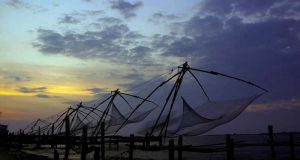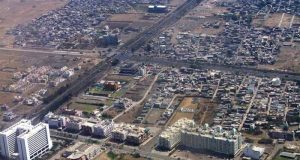Panchmarhi – The Queen of the Satpura Range
Pachmarhi, also known for the Panchmarhi Cantonment, is a tourist destination and a hill station situated in the Hoshangabad district of Madhya Pradesh, central India. It is popularly called ‘Satpura ki Rani’, as it is at an altitude of 1000 m in the Satpura Range of the Hoshangabad district.

Pachmarhi is the state’s luxuriant gem where nature resides and expresses itself through innumerable captivating mediums. Green shades on the mountains offer freshness, the atmosphere conveys the calm mumble of the flowing water, and the bristle lanes seem to walk along with the dense sal and bamboo forests and orchard of Jamun. Adding to nature’s beauty are the architectural and archaeological works since time immemorial.
Pachmarhi is in the Pachmarhi Biosphere Preserve built-in 1999 in order to connect two forest reserves for a grand wildlife conservation region. The town, not big in area, is under the supervision of the Indian Army with the majority of the population being in the Army. The civilian town, towards the lake, covers a few hotels, a movie hall, and a bazaar. Tigers and panthers’ sightings are common. The town is rich in timber and teak, but no new plantations/cutting is permitted. For any construction around the town, approval of the Central and State governments is inevitable.
History
In 1857, Captain James Forsyth belonging to the British Army made the town popular in the western countries. Thereafter, Pachmarhi was a hill station, infirmary, and summer capital for the British.
In May 2009, UNESCO designated Pachmarhi as a part of the Biosphere Reserves.
Tourists’ Attractions
Priyadarshini

This is the Forsyth point that commemorates the place from where Captain Forsyth discovered Panchmarhi. The British developed Pachmarhi which can be seen in its churches and colonial built-up.
Jamuna Prapat (Bee Fall)
This is a glorious waterfall in the stream that is the source of drinking water for the entire town. Above the fall, there are famous bathing pools.
Handi Khoh

This is an eye-catching narrow valley due to its high rock face of 300 feet and steep edges.
Rajat Prapat (Big Fall)
It takes a 10-minute walk crossing rocks and boulders from Apsara Vihar to reach the place. This is an opportunity for adventurous people.
Irene Pool
This pool is named after Irene Bose who found it and wife of Justice Vivian Bose. The upstream heads towards a cave from where the stream flows underground and from there, it flows above a khud as a series of falls.
Apsara Vihar (Fairy Pool)

This is a picnic spot for small children due to its shallowness. The pool only deepens towards the fall’s base.
Jalawataran (Duchess Falls)
Steep being the fall and arduous being the trek, is for around 4 km to the fall’s base.
Sunder Kund (Saunders Pool)
This is a large rocky pool for revitalizing swim that comes after passing through the stream below Duchess Fall and then walking about 2.5 km southwest.
Bada Mahadev

This is the holy hill where there is an idol of Lord Shiva and a Shiv Linga. In the east, there is a cave hosting attractive cave paintings, which are originally 10,000 years old.
Chhota Mahadeo
This is a holy narrow point in the valley that has overhanging rocks and cascading water springs.
Chauragarh

Near Mahadeo, it is a major summit decorated with the motifs of the Mahadeo worship.
Bison Lodge
This has been the ancient house since 1862 and holds a museum of flora and fauna of the town.
Jata Shankar

This is a holy cave under loose rocks wherein the Jambu Dwip stream originates. The name of this place is from the formation of rocks that look like the intertwined curls of Lord Shiva
Dhupgarh
This is the highest summit (1100 m) in Central India that offers you splendid scenes of the mountainous ranges and sunsets.
Pandav Caves

These are five old dwellings carved out of the sandstone rock. The town has got its name from these caves. According to the legend, these caves provided shelter to the five Pandav brothers described in Mahabharata.
Tridhara (Piccadily Circus)
This is a picnic spot and a junction of two streams.
Vanshree Vihar (Pansy Pool)
This is on the Denwa stream with shady trees and vegetation.
Reechhgarh

This is a natural amphitheater that can be reached through a cave-like entrance on the south.
Sangam (Fuller’s Khud – Waters Meet)
This is the lowest picnic spot on the Denwa stream and is famous for above and below bathing pools.
Christ Church
This was built in 1875 with its sanctum-sanctorum hosting a semi-circular dome with faces of angels. It also has the stained glass panes and back of the altar brought from Europe, whose view is worth seeing when the sunrays pass. The church’s nave is without a single pillar, the baptismal print is an uncommon brass work, and the bell’s chimes are heard from a long distance.
Catholic Church

This is a mix of French and Irish styles having Belgium stained-glass windows built-in 1892. It also has a graveyard wherein graves are from 1859 including World War I and II.
Harper’s Cave
This is near the Jata Shankar shrine and its name is due to a painting of a man playing the harp.
Chieftain’s Cave
This name is due to a painting depicting two chieftains on horses.
Satpura National Park

It covers the dense forest of sal, teak, and bamboo and was made in 1981. The summits of Dhupgarh and Mahadeo, deep valleys of Panchmarhi, high mountains, streams, waterfalls, and Tawa’s huge reservoir are the attractions of this park. The park also houses tiger, leopard, bison, bear, four-horned deer, blue bull, and different birds.
Tamia
This is famous as an excursion spot. It offers the view of the Dudhi plateau from 330 meters of the cliffs and is 78 km away from Pachmarhi.
The Cave Shelters

These include Dhuandhar, Bharat Neer (Dorothy Deep), and Asthachal (Monte Rosa). Dhuandhar is within walking distance to Apsara Vihar and houses white paintings of archers. Bharat Neer also houses animal paintings and it was at this place that many pottery remains and microliths were found during excavation. Asthachal is four shelters of paintings. On the north of Jambu Dwip valley, there are six homes with paintings of animals and human figures and a battlefield.
Days of Attraction
There is no special time to visit Pachmarhi.
Reaching Pachmarhi
By air, Bhopal is the nearest airport at a distance of 195 km and is well connected to major cities of India. By rail, Pipariya at 47 km is the desired rail station on the Mumbai-Howrah line via Allahabad. By road, there are regular buses from Bhopal, Hoshangabad, Nagpur, Pipariya, and Chhindwara. In addition, taxis can be hired from Pipariya.


